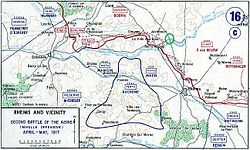
Back Emgann Chemin des Dames Breton Schlacht an der Aisne (1917) German Aisneko bigarren gudua Basque Aisnen toinen taistelu Finnish Bataille du Chemin des Dames French הקרב השני על האן HE Pertempuran Aisne Kedua ID Seconda battaglia dell'Aisne Italian Втора битка на Ена Macedonian Batalha dau Camin dei Damas Occitan
| Second Battle of the Aisne | |||||||
|---|---|---|---|---|---|---|---|
| Part of the Western Front of the First World War | |||||||
 Chemin des Dames and Champagne, 1917 | |||||||
| |||||||
| Belligerents | |||||||
|
|
| ||||||
| Commanders and leaders | |||||||
|
|
| ||||||
| Strength | |||||||
| 53 divisions | 38 divisions | ||||||
| Casualties and losses | |||||||
| c. 187,000 | c. 163,000 | ||||||
The Second Battle of the Aisne (Bataille du Chemin des Dames or Seconde bataille de l'Aisne, 16 April – mid-May 1917) was the main part of the Nivelle Offensive, a Franco-British attempt to inflict a decisive defeat on the German armies in France. The Entente strategy was to conduct offensives from north to south, beginning with an attack by the British Expeditionary Force (BEF) then the main attack by two French army groups on the Aisne. General Robert Nivelle planned the offensive in December 1916, after he replaced Joseph Joffre as Commander-in-Chief of the French Army.
The objective of the attack on the Aisne was to capture the prominent 80 km (50 mi), east–west ridge of the Chemin des Dames, 110 km (68 mi) north-east of Paris and then advance northwards to capture the city of Laon. When the French armies met the British advancing from the Arras front, the Germans would be pursued towards Belgium and the German frontier. The offensive began on 9 April, when the British began the Battle of Arras. On 16 April, the Groupe d'armées de Reserve (GAR, Reserve Army Group) attacked the Chemin des Dames and the next day, the Fourth Army, part of Groupe d'armées de Centre (GAC, Central Army Group), near Reims to the south-east, began the Battle of the Hills.
The Chemin des Dames ridge had been quarried for stone for centuries, leaving a warren of caves and tunnels which were used as shelters by German troops to escape the French bombardment. The offensive met massed German machine-gun and artillery fire, which inflicted many casualties and repulsed the French infantry at many points. The French achieved a substantial tactical success and took c. 29,000 prisoners but failed to defeat decisively the German armies. The failure had a traumatic effect on the morale of the French army and many divisions mutinied. Nivelle was superseded by General Philippe Pétain, who adopted a strategy of "healing and defence", to resume the wearing-out of the German Army while conserving French infantry. Pétain began a substantial programme re-equipment of the French Army, had 40–62 mutineers shot as scapegoats, provided better food, more pay and more leave, which led to a considerable improvement in morale.
The new French strategy was not one of passive defence; in June and July the Fourth, Sixth and Tenth Armies conducted several limited attacks and the First Army was sent to Flanders to participate in the Third Battle of Ypres. The British prolonged the Arras offensive into mid-May, despite uncertainty about French intentions, high losses and diminishing returns, as divisions were transferred northwards to Flanders. The British captured Messines Ridge on 7 June and spent the rest of the year on the offensive at Ypres (31 July – 10 November) and the Battle of Cambrai (20 November – 8 December). The mutinies in the French armies became known to the Germans but the cost of the defensive success on the Aisne made it impossible to reinforce Flanders and conduct more than local operations on the Aisne and in Champagne. A French attack at Verdun in August completed the recapture of much of the ground lost in 1916. The Battle of La Malmaison in October captured the west end of the Chemin des Dames and forced the Germans to withdraw to the north bank of the Ailette.
© MMXXIII Rich X Search. We shall prevail. All rights reserved. Rich X Search